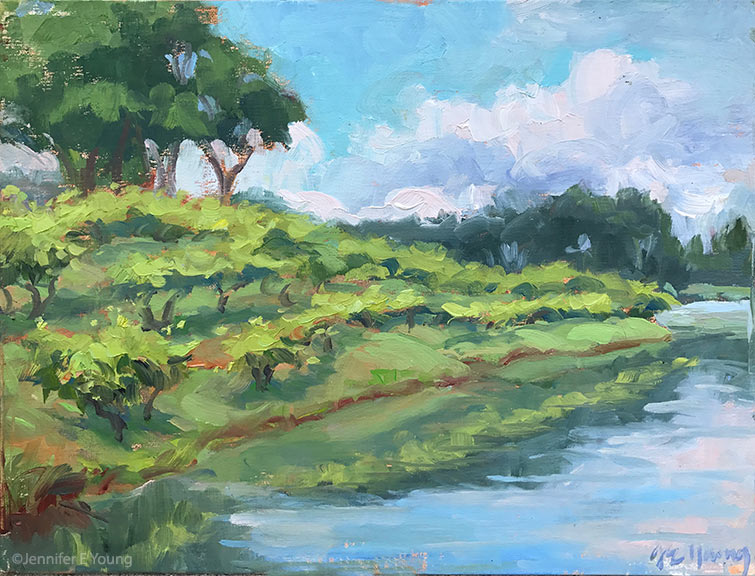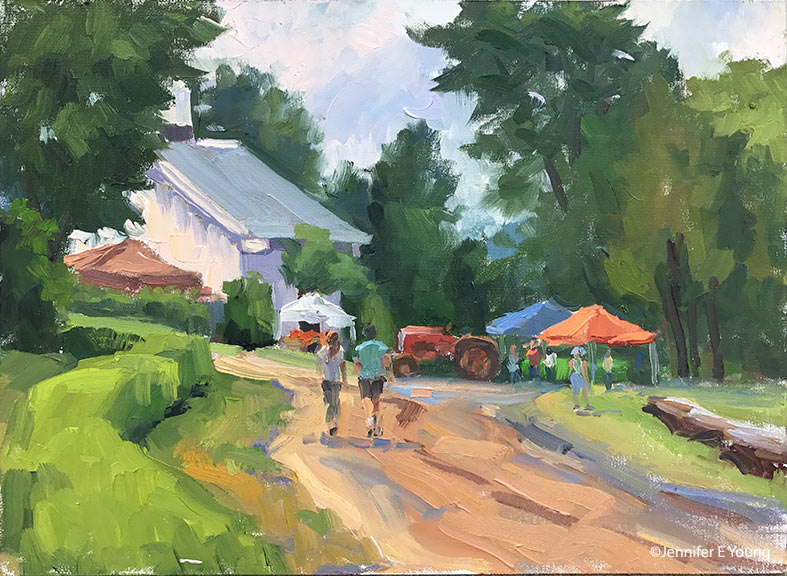If you thought this was going to be a post about raucous overindulgence at Christmas parties, you'll be sorely disappointed. ;-) This post is about something else I've been consuming (or rather, something that's been consuming me) -- information about lighting for the new studio. This post may have limited appeal, but since there is such an overwhelming amount of information both online and off in regards to full spectrum lighting, I thought I'd share some of my thoughts for other artists who might have some of the same considerations. As I'd mentioned in my previous post, I believe the best choice I've found for general non-directional studio light from an artificial source is in the form of full-spectrum tube fluorescents. Of course, full spectrum is a bit of a misnomer, because NOBODY is going to mistake fluorescent lighting (or any artificial light, for that matter) for natural daylight. But what fluorescents do provide is a more even lighting that can't easily be achieved by track lights or other kinds of task lights I've researched. Here are some other things I've discovered:
Fluorescent Full Spectrum Lighting
There are a lot of products out there claiming to be "Full Spectrum" fluorescents, and while fluorescent lighting has come a long way from the lights you've seen in old office buildings or "big box" retail stores, fluorescents simply cannot truly mimic the spectral rendering achieved by natural daylight. The reason for this is that even the best full spectrum fluorescents experience mercury spikes, particularly in the blue and green ends of the spectrum, as well as dips or gaps in the reds. Compared to daylight, where the full spectrum is rendered without gaps, spikes, and dips, it's understandable why some people complain that full spectrum fluorescent lights can seem "cold" or "harsh." Nevertheless, advances have definitely be made in these lamps so that they give off a much cleaner, whiter light than the old yellow fluorescents of yore.
Color Temperature and Color Rendering
I also previously mentioned that the Kelvin temperature of daylight ranges from around 5000K to 5900K. Actually, this is a bit inaccurate, as there are different temperatures of daylight. But for my purposes, this range is supposed to give me a clean, white light with all colors being more or less balanced with little to no color bias.
But color temperature alone doesn't tell the whole story. Two lamps stating a color temperature of 5000K can still render colors differently, so it's also important to consider the color rendering index (CRI) of the lamp. Wikipedia gives a good definition of CRI in the excerpt below:
"The color rendering index (CRI) (or colour rendering index in British English; sometimes called color rendition index), is a quantitative measure of the ability of a light source to reproduce the colors of various objects faithfully in comparison with an ideal or natural light source. Light sources with a high CRI are desirable in color-critical applications such as photography and cinematography. "
In the world of fluorescent lighting, lamps with a CRI of 80 or above are considered to have high color rendering. But in graphics, photography, and film, there is a big difference between a CRI of 80 and one of 90, so I'll be looking closely at lamps with a CRI of 90 and above.
Quality Vs. Quantity
Okay, great! I know I'll get pretty good quality of light if I can find a lamp in the 5000K range with a CRI of 90 or above. But here's the rub. Typically fluorescent lamps with the highest CRI's have a lower lumen output per lamp (meaning they aren't as bright). So when shopping around, it's important consider the "design lumens" of the bulb or you might not get as much light from your lamps as you expect.
T12's, T8's, or T5's?
Fluorescents come in a number of shapes and sizes. The most common tube-type lamps are probably the T12's, though the smaller diameter T8's are quickly gaining ground and in my town I'm seeing more and more T8 lamps stocked in the "big box" stores. The benefit of the T8 lamp is its ability to give off the same amount of light as the thicker T12's, using fewer lamps (hence less energy) and less mercury. T5's are even thinner, and the same principle applies in terms of light output and energy use, though since they are among the newest offerings they aren't as readily available in my area should I be in need of a quick replacement.
On the up side, any one of these lampsinstalled in the appropriate fixture should last a good long while--several years, in fact. Most lamps claim an average life-span of about 20000 hours. Compare that to about 3000 rated hours for better halogen bulbs like Solux, and you can see the advantage of the fluorescents for general lighting (especially on a 15 foot ceiling!)
Let there be light!
So what have I concluded? I'm going to start with some 4-foot T8 fluorescent fixtures and lamps that offer the best color rendering/color temperature/light output that I can find. I suspect I will have to experiment with different bulbs and/or combinations to find a level and quality of light that I'm comfortable working with (see links below for an interesting "studio lighting experiment" and discussion). I also plan to have track lighting installed and will outfit some of the track fixtures in my work area with Solux bulbs and diffusers. It's my hope that blending these light sources with the natural light from my windows will give me a good combination of clean, balanced, diffused light for my new studio.
Further Reading:
Studio lighting experiment: Check out this discussion on WetCanvas! complete with visuals showing the quality of the fluorescent light with bulbs of different color temperatures.
Is it really full spectrum or a marketing ploy? This Wikipedia entry casts doubt on the benefits and accuracy of products marketed as full spectrum lighting.
More than you ever wanted to know about fluorescent fixtures: This article compares the use of fluorescents versus Metal Halides in commercial lighting, but has some good general info about fluroescent fixtures about half way down the page.
Visual comparison of full spectrum fluorescent lights to Solux bulbs: Keep in mind this is Solux's marketing material, but it does have some interesting graphics showing the spectral spikes, gaps and dips characteristic in fluorescent lamps.
P.S. This is part of a series of posts I've explored while building my new art studio. For my additional in-depth analysis on studio lighting for artists, go here and here.























